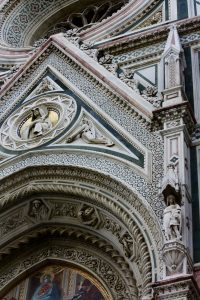Riomaggiore, Italy
 Martin and I are tucked away safe in our cozy apartment. It is on the second floor of an ancient stone building, within a maze of twisting and turning steps and tiny courtyards. The walls are two feet thick, chunky whitewashed stone. The wooden ceiling is suspended by roughy hewn two by fours and whole pine tree trunks. The floor is terra cotta. All is dry. Radiant heaters warm the room. For the moment, all is still.
Martin and I are tucked away safe in our cozy apartment. It is on the second floor of an ancient stone building, within a maze of twisting and turning steps and tiny courtyards. The walls are two feet thick, chunky whitewashed stone. The wooden ceiling is suspended by roughy hewn two by fours and whole pine tree trunks. The floor is terra cotta. All is dry. Radiant heaters warm the room. For the moment, all is still.
 The main street of Riomaggiore nestles in a gorge that nature cut between two soaring mountain ridges that cling on the very edge of the land, on the Ligurian coast. Martin and I arrived yesterday afternoon in the rain, barely getting a glimpse of the dramatic coastal plunge into the sea.
The main street of Riomaggiore nestles in a gorge that nature cut between two soaring mountain ridges that cling on the very edge of the land, on the Ligurian coast. Martin and I arrived yesterday afternoon in the rain, barely getting a glimpse of the dramatic coastal plunge into the sea.
Today, as we ventured out for groceries and some lunch, shops and cafes were closed and shuttered — even the international bar. Were they all taking a lunch siesta? Signs on the doors: So sorry, closed for bad weather. Bad weather? Aww, they just want the day off. Are these Italians afraid of a little rain? Why, we have been to Denmark and Norway. We aren’t afraid. Even the tourist information center was not opening its doors. We stood at the darkened entrance mystified. A kind Italian-speaking Swede enlightened us: Bad storm expected, a “red” designation, schools closed, high alert. Advice: Get food now.
As we walked up the street,one brave bar was open. I’m sure it will have some loyal patrons today. Further up the street, only Mama Mia’s open, and doing quite a brisk business. We snapped up whatever we could carry, and home we went.
Hit the internet before electricity goes out. The European “Meteoalarm” indicates “red” alert for Liguria — rain, lightning and wind. What does red mean? “The weather is very dangerous. . . Exceptionally intense meteorological phenomena . . . threat to life and limb . . . Follow orders and any advice given by your authorities . . . be prepared for extraordinary measures.”
 Well, the only orders that are being obeyed is to not report for work or feed tourists. I am wondering what “extraordinary measures” are required. There was no place to buy candles, or matches for that matter. The wine shop was shut. We have procured, however, an immense paper cone of fried calamari and another one of fried anchovies. To round out our rations, we have a supply of onion focaccia, white pizza and thin chickpea and cheese pancakes. God bless Mama Mia.
Well, the only orders that are being obeyed is to not report for work or feed tourists. I am wondering what “extraordinary measures” are required. There was no place to buy candles, or matches for that matter. The wine shop was shut. We have procured, however, an immense paper cone of fried calamari and another one of fried anchovies. To round out our rations, we have a supply of onion focaccia, white pizza and thin chickpea and cheese pancakes. God bless Mama Mia.
Some “intense meteorological phenomena” did manifest — lashing rain, wind crashing the shutters shut, water cascading down the roofs, and thunder pounding on the mountains. Church bells began tolling. I started to think not about God, but about the name, Riomaggiore. Wouldn’t that mean something to the effect of major river? However, there was no major river. Would the name imply that the major street becomes a river?
Well, you will just have to come back and read of the further adventures of Martin and Pat to find out.


 Martin and I stayed in an apartment above a canal; the little courtyard even had its own portal to the canal. At night, we could hear gondoliers singing, lovers laughing and Italian families having dramatic conversations.
Martin and I stayed in an apartment above a canal; the little courtyard even had its own portal to the canal. At night, we could hear gondoliers singing, lovers laughing and Italian families having dramatic conversations.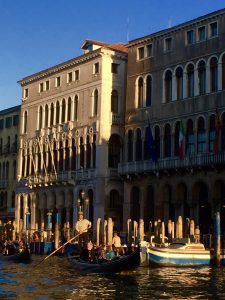 Venice was quite cold and alternated between a few sunny days and days of rain. Regardless of the weather, we gleefully immersed ourselves in the art, history and beauty of the city. Venice in autumn had a special kind of light.
Venice was quite cold and alternated between a few sunny days and days of rain. Regardless of the weather, we gleefully immersed ourselves in the art, history and beauty of the city. Venice in autumn had a special kind of light. Everyone in Europe wears scarves; it is quite the fashion item. So I, too, wrapped my neck fashionably and stayed warm. The incredibly good food in Venice kept us going. One of our favorite restaurants was right in our little courtyard.
Everyone in Europe wears scarves; it is quite the fashion item. So I, too, wrapped my neck fashionably and stayed warm. The incredibly good food in Venice kept us going. One of our favorite restaurants was right in our little courtyard.











 Martin and I did the two-hour hike from Monterosso al Mare to Vernazza, and as we approached the village, we were greeted by a pleasant surprise: there on our path was our favorite restaurant from two days ago. We practically fell into the arms of the waiter as we gratefully entered the terrace. A fresh breeze greeted us. The sea was glistening hundreds of feet below the bluff, absolutely jaw-dropping. When we recovered control of our jaw muscles, we dove into the best bruschetta in Italy.
Martin and I did the two-hour hike from Monterosso al Mare to Vernazza, and as we approached the village, we were greeted by a pleasant surprise: there on our path was our favorite restaurant from two days ago. We practically fell into the arms of the waiter as we gratefully entered the terrace. A fresh breeze greeted us. The sea was glistening hundreds of feet below the bluff, absolutely jaw-dropping. When we recovered control of our jaw muscles, we dove into the best bruschetta in Italy.
 The path to Manerola began in the village, and then went up, up, up . . . up. We had spotted the 45-minute trail sign when entering the village. We ambled through the village to see its sights, fortified ourselves with a healthy dose of caffeine, and were up and raring to go on our first hike in Cinque Terre. We spotted a sign for our destination, Manerola, and blithely started bounding up the steps.
The path to Manerola began in the village, and then went up, up, up . . . up. We had spotted the 45-minute trail sign when entering the village. We ambled through the village to see its sights, fortified ourselves with a healthy dose of caffeine, and were up and raring to go on our first hike in Cinque Terre. We spotted a sign for our destination, Manerola, and blithely started bounding up the steps.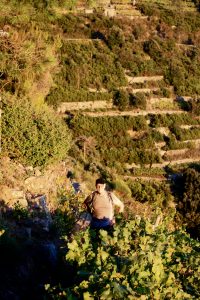 The terrain was fascinating. Ancient vineyards and olive groves clung to the steep hillsides, held by stone terraces, called schiattiati. These were built by hand by farmers centuries ago, and to this day are maintained by them. No machinery here. Transportation to market is by foot. The path was a series of narrow, rough stone steps and pathways formed by stones of every shape sunk partway into the dirt on the edge of narrow bands of cultivation. We were literally walking on the terrace walls alternating with narrow stone steps from one terrace to another.
The terrain was fascinating. Ancient vineyards and olive groves clung to the steep hillsides, held by stone terraces, called schiattiati. These were built by hand by farmers centuries ago, and to this day are maintained by them. No machinery here. Transportation to market is by foot. The path was a series of narrow, rough stone steps and pathways formed by stones of every shape sunk partway into the dirt on the edge of narrow bands of cultivation. We were literally walking on the terrace walls alternating with narrow stone steps from one terrace to another. Forty minutes into the hike we were getting higher and higher, with no village in sight. We encountered returning hikers and they without mercy informed us that we had two more hours to go! Mistakenly, we had taken the mountain route! My soul was singing, so filled I was with the magnificent views. My thighs, calves, knees and feet were screaming for leniency. There was only one thing to do, and that was for M and P to keep on Treking.
Forty minutes into the hike we were getting higher and higher, with no village in sight. We encountered returning hikers and they without mercy informed us that we had two more hours to go! Mistakenly, we had taken the mountain route! My soul was singing, so filled I was with the magnificent views. My thighs, calves, knees and feet were screaming for leniency. There was only one thing to do, and that was for M and P to keep on Treking. At long last, we spotted our destination, Manerola, sprawled languidly on a bluff above the ocean. Below us was the clear azure sea. Hope restored! Soon, we were sitting on a beachfront deck with our shoes off and our feet up, sipping chilled Cinque Terre wine.
At long last, we spotted our destination, Manerola, sprawled languidly on a bluff above the ocean. Below us was the clear azure sea. Hope restored! Soon, we were sitting on a beachfront deck with our shoes off and our feet up, sipping chilled Cinque Terre wine.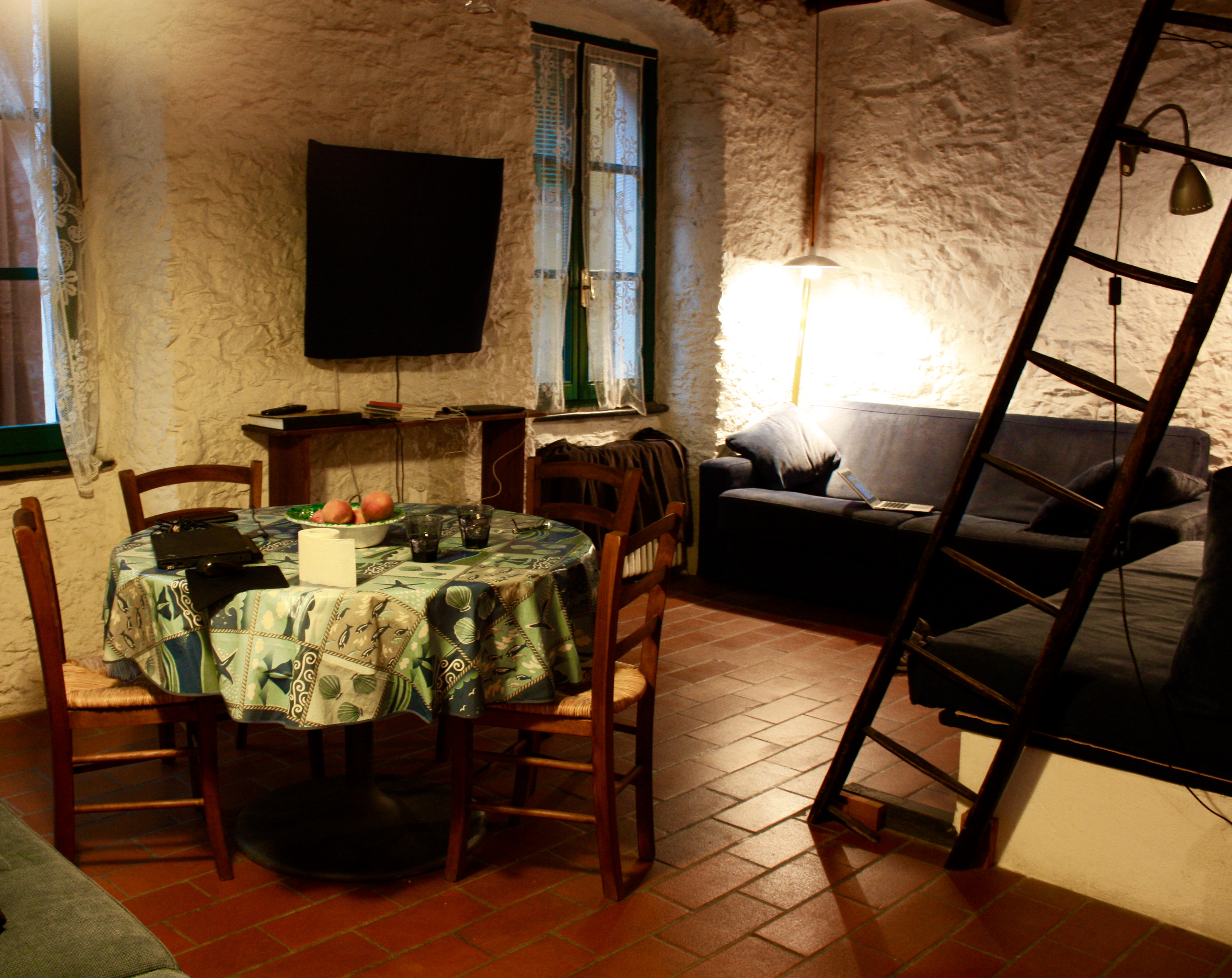
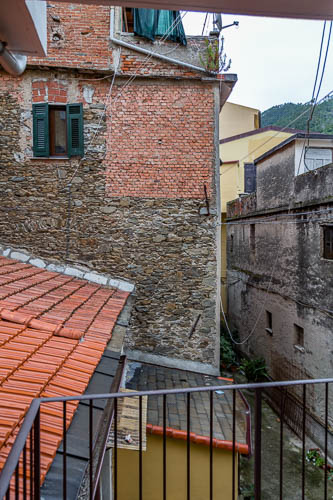 Martin and I are tucked away safe in our cozy apartment. It is on the second floor of an ancient stone building, within a maze of twisting and turning steps and tiny courtyards. The walls are two feet thick, chunky whitewashed stone. The wooden ceiling is suspended by roughy hewn two by fours and whole pine tree trunks. The floor is terra cotta. All is dry. Radiant heaters warm the room. For the moment, all is still.
Martin and I are tucked away safe in our cozy apartment. It is on the second floor of an ancient stone building, within a maze of twisting and turning steps and tiny courtyards. The walls are two feet thick, chunky whitewashed stone. The wooden ceiling is suspended by roughy hewn two by fours and whole pine tree trunks. The floor is terra cotta. All is dry. Radiant heaters warm the room. For the moment, all is still. The main street of Riomaggiore nestles in a gorge that nature cut between two soaring mountain ridges that cling on the very edge of the land, on the Ligurian coast. Martin and I arrived yesterday afternoon in the rain, barely getting a glimpse of the dramatic coastal plunge into the sea.
The main street of Riomaggiore nestles in a gorge that nature cut between two soaring mountain ridges that cling on the very edge of the land, on the Ligurian coast. Martin and I arrived yesterday afternoon in the rain, barely getting a glimpse of the dramatic coastal plunge into the sea. Well, the only orders that are being obeyed is to not report for work or feed tourists. I am wondering what “extraordinary measures” are required. There was no place to buy candles, or matches for that matter. The wine shop was shut. We have procured, however, an immense paper cone of fried calamari and another one of fried anchovies. To round out our rations, we have a supply of onion focaccia, white pizza and thin chickpea and cheese pancakes. God bless Mama Mia.
Well, the only orders that are being obeyed is to not report for work or feed tourists. I am wondering what “extraordinary measures” are required. There was no place to buy candles, or matches for that matter. The wine shop was shut. We have procured, however, an immense paper cone of fried calamari and another one of fried anchovies. To round out our rations, we have a supply of onion focaccia, white pizza and thin chickpea and cheese pancakes. God bless Mama Mia.









